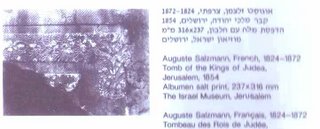Flaubert's Observations of Jerusalem and the Jews Living There [1850]

9 August 1850The Holy City was fully under Muslim/Ottoman control in 1850. This was before Western influence grew in Jerusalem after the Crimean War [1856], when France and Britain defended the Ottoman Empire against Russia, thus earning the right to demand favors in Jerusalem from the Sultan. Jews had been the largest single ethnic-religious group in the Holy City since 1839, and a French diplomat reported in 1853, a few years after Flaubert's visit, that the Jews formed an absolute majority of the city's population. To be sure, a few consuls were in place in 1850, one of them the Frenchman, Paul-Emile Botta. Indeed, the first consul, a Britisher, had set himself up in 1839. Missionaries too were operating in Jerusalem in 1850, but relatively new in town. By Islamic law, they were allowed only to proselytize among Christians and Jews, not among Muslims. Some Christians went over from the Greek Orthodox Church to various Protestant sects. The number of Jews converted was very few, especially considering the vast funds spent on converting them.
Jerusalem has the effect of a fortified pile of corpses. There, old religions rot in silence. One walks over s--- and sees only ruins. It is enormously sad. . .
11 August 1850
. . . But how all that is false! How they lie [seemingly referring to the guides for Western tourists and pilgrims]! How crudely painted it is, how cheap looking, how varnished, made for exploitation, for propaganda and for displaying merchandise! Jerusalem is a charnel house surrounded by walls. The first curious thing that we encountered was the butcher shop. In a sort of square place, covered with mounds of garbage, a large hole. In the hole, scorched blood, entrails, s---, blackish and brown guts almost burnt by the sun, all around. There was a very strong stench. . .
Everything was silent [partly because of the Muslim Bairam holiday], we heard no noise, no one was passing by. Here and there, along the wall and making way for us, a Polish Jew, tall, bearded, with his wide fox fur hat. The bazaars are closed. It is Bairam, which, for each change of the Muslim day and night, causes a strong quantity of cannon shots to be fired. The shop fronts seem chewed by the dust and some are falling into ruin. . .
. . . the Mosque of Omar [`Umar] built on the location of the Temple.
The next morning, we rose at six o'clock in order to go see the Jews weep before the remains of its walls. They are, at the base, [built] of huge stones which are reminiscent of Egypt due to the power of the work, squared off and ornamented with an inner quadrilateral [actually with rectangles] similar to the one that carpenters make on the flat surface of doors [These huge stones are basically rectangular cubes].
An old Jew in a corner, his head covered with his white garment, barefoot, and chanting something in a book, his back turned towards the wall, while rising up and down on his heels. The same construction, the same wall is found on the other side of the Temple, on the east side. As we were going away from there, we met other Jews who were probably coming there. . .
[while smoking] in a cafe'. . . we noticed a large square pool (the pool of Ezekiel [correctly: Hezekiah's Pool in the Christian Quarter]), full of greenish water, surrounded by high walls pierced here and there, in a few places, by small irregular windows. These were the back walls of the surroundings houses.
. . . Dinner with Botta [French consul]. . . in the city of ruins. . .
. . . visit to the Holy Sepulcher. The exterior with its romanesque parts, excited us. . . The keys are with the Turks, otherwise the Christians of all the sects would tear each other apart.
[quoted in: Claude Aziza, Jerusalem: le reve a` l'ombre du Temple ("Collection Omnibus"; Paris: Presses de la Cite, 1994), pp 1280-1283]

Note that Flaubert, writing in 1850, sees the Temple Mount as important because it was the location of the ruined Jewish Temple, whereas the "Mosque of Omar" [Dome of the Rock] is important because it is on the site of the Temple. The Holy City under Muslim/Ottoman rule was filthy, unhygienic, and stench-ridden. Old buildings were in ruins. The massive stones of the Temple make a strong impression on Flaubert, while he is disappointed with the commercial atmosphere surrounding the Church of the Holy Sepulcher and is not much impressed with the Muslim structures. Muslims held the keys of this Church [in fact, not Turks but an Arab-Muslim family that was paid for its services]. Flaubert and his fellow tourists/pilgrims are interested in the sight of Jews praying and weeping at the Western Wall prayer place. That section of the Wall --actually a retaining wall of the Temple Mount-- was customarily called in the West the Wailing Wall or a similar term in other Western languages [for example, Mur de Lamentations].
[Photos from Focus East, Early Photography in the Near East 1839-1885 (Jerusalem: Israel Museum 1988)]
- - - - - - - -
Coming: More on Jews in Jerusalem, Pierre Loti's account, British aid for the Arab war on Israel in 1948, etc.


1 Comments:
What an important retrack in history.
See my post about 120 years to first of Arab attack on Jews in Israel, 1886 Petach Tikva.
By Free Israel, at 10:02 PM
Free Israel, at 10:02 PM
Post a Comment
<< Home